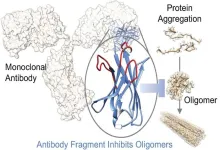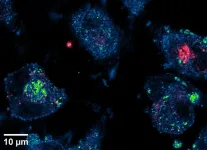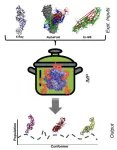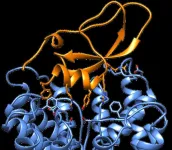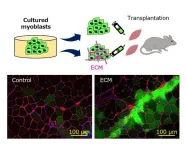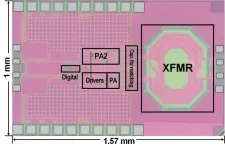(Press-News.org) University of Leeds news
Embargoed until 05:01 GMT, 17 February
Reintroducing wolves to the Scottish Highlands could lead to an expansion of native woodland which could take in and store one million tonnes of CO2 annually, according to a new study led by researchers at the University of Leeds.
The team modelled the potential impact that wolves could have in four areas classified as Scottish Wild Land, where the eating of tree saplings by growing red deer populations is suppressing natural regeneration of trees and woodland.
They used a predator–prey model to estimate that a reintroduction of wolves to areas in the Cairngorms, South-west Highlands, Central Highlands and North-west Highlands would lead to a total population of around 167 wolves – enough to reduce red deer populations to a level that would allow trees to regenerate naturally.
Control of red deer by wolves could lead to an expansion of native woodland that would take up - or sequester - one million tonnes of CO2 each year - equivalent to approximately 5% of the carbon removal target for UK woodlands that has been suggested by the UK’s Climate Change Committee as being necessary to reach net-zero by 2050.
The researchers estimate that each wolf would lead to an annual carbon uptake capability of 6080 tonnes of CO2, making each of the predators "worth" £154,000, using accepted current valuations of carbon.
The results of their study are published today (17 February 2025) in the journal Ecological solutions and Evidence
This is the first time that the potential impacts of a wolf reintroduction on woodland expansion and carbon storage in the UK have been assessed, and the researchers believe the results provide further evidence of the role large carnivores can play in delivering the nature-based solutions required to address the climate emergency.
Lead author Professor Dominick Spracklen of the University of Leeds’ School of Earth and Environment said: “There is an increasing acknowledgement that the climate and biodiversity crises cannot be managed in isolation.
“We need to look at the potential role of natural processes such as the reintroduction of species to recover our degraded ecosystems and these in turn can deliver co-benefits for climate and nature recovery.”
Wolves were eradicated from Scotland around 250 years ago, leaving red deer with no natural predators and allowing their populations to grow across the country. Despite ongoing management, red deer numbers in Scotland have significantly increased over the last century, with the latest estimates thought to be as high as 400,000.
Lack of natural tree regeneration has contributed to the long-term decline and loss of native woodland. Scotland today has one of the lowest levels of native woodland in Europe, with only 4% of country covered. The natural regeneration of trees is largely restricted to areas where deer are excluded by fencing. More intensive deer management in some locations has been shown to help tree regeneration, with an increasing number of seedlings when red deer numbers were reduced to fewer than four per km2.
Discussions around potential large carnivore introductions to the UK and elsewhere are ongoing. The wolf population in western Europe now exceeds 12,000 and they occupy 67% of their former European historical range, including human-dominated landscapes in Central Europe. Even the Netherlands, a country considerably more densely populated than Scotland now has wolves resident again.
The researchers recognise that the debate around the reintroduction of wolves to the Scottish Highlands will not be without controversy, particularly among livestock farmers and deer stalkers.
However, they argue that benefits of reintroducing wolves need to be considered. The financial benefits associated with carbon uptake and storage would be in addition to the other well documented economic and ecological impacts of wolf reintroduction, including ecotourism, a reduction in deer-related road traffic accidents, a reduction in Lyme disease associated with deer and a reduction in the cost of deer culls.
Lee Schofield, a co-author of the study, added: “Our aim is to provide new information to inform ongoing and future discussions about the possibility of wolf reintroductions both in the UK and elsewhere.
“We recognise that substantial and wide-ranging stakeholder and public engagement would clearly be essential before any wolf reintroduction could be considered. Human-wildlife conflicts involving carnivores are common and must be addressed through public policies that account for people’s attitudes for a reintroduction to be successful.”
Ends
Further information
For media enquiries, please contact Kersti Mitchell in the University of Leeds press office via k.mitchell@leeds.co.uk
The University of Leeds is one of the largest higher education institutions in the UK, with more than 40,000 students from about 140 different countries. We are renowned globally for the quality of our teaching and research.
We are a values-driven university, and we harness our expertise in research and education to help shape a better future for humanity, working through collaboration to tackle inequalities, achieve societal impact and drive change.
The University is a member of the Russell Group of research-intensive universities, and is a major partner in the Alan Turing, Rosalind Franklin and Royce Institutes www.leeds.ac.uk
Follow University of Leeds or tag us in to coverage: Bluesky | Facebook | LinkedIn | Instagram
END
Reintroducing wolves to Scottish Highlands could help address climate emergency
2025-02-17
ELSE PRESS RELEASES FROM THIS DATE:
New antibody discovery platform can inform Alzheimer's and Parkinson's
2025-02-15
ROCKVILLE, MD – In diseases like Parkinson's and Alzheimer's, specific proteins misfold and clump together, forming toxic aggregates that damage brain cells. The process of proteins spontaneously clumping is called protein aggregation and researchers have developed novel methods to generate aggregate-specific antibodies as specific probes or modulators of the aggregation process.
This new method overcomes significant challenges in characterizing these complex and often transient protein structures. The work will be presented at the 69th Biophysical ...
The Biophysical Journal names Marcel P. Goldchen-Ohm the 2024 Paper of the Year-Early Career Investigator awardee
2025-02-15
ROCKVILLE, MD – Marcel P. Goldschen-Ohm, of the University of Texas at Austin, USA will be honored as the recipient of the Biophysical Journal Paper of the Year-Early Career Investigator Award at the 69th Annual Meeting of the Biophysical Society, held February 15-19 in Los Angeles, California. This award recognizes the work of outstanding early career investigators in biophysics. The winning paper is titled “GABAA Receptor Subunit M2-M3 Linkers Have Asymmetric Roles in Pore Gating and Diazepam Modulation.” The paper was published in Volume 123, Issue 14 of Biophysical Journal.
GABAA receptors mediate inhibitory synaptic signaling ...
A new system to study phytoplankton: Crucial species for planet Earth
2025-02-15
ROCKVILLE, MD – Phytoplankton, tiny plant-like organisms in the ocean, are incredibly important for life on Earth. They're a major food source for many sea creatures and produce almost half the oxygen we breathe. They also help control the climate by soaking up a lot of carbon dioxide, a gas that contributes to global warming.
Scientists want to learn more about how these phytoplankton use sunlight to make energy and oxygen, which can be useful in the context of environmental monitoring during ...
Scientists discover "genetic weak spot" in endangered Italian bear population
2025-02-15
ROCKVILLE, MD – The Apennine brown bear, also known as the Marsican brown bear (Ursus arctos marsicanus), is a unique and critically endangered subspecies of brown bear found only in the remote and rugged Apennine Mountains of central Italy.
A new study by the Italian Endemixit project (endemixit.com) reveals a potentially critical genetic flaw in the endangered Apennine brown bear population of Italy, offering insights that could help boost conservation efforts. The work will be presented at the 69th Biophysical Society Annual Meeting, to be held February 15 - 19, 2025 in Los Angeles.
This distinct population has been isolated for centuries, evolving unique physical ...
New insights into Alzheimer's brain inflammation
2025-02-15
ROCKVILLE, MD – Brain inflammation, while a crucial part of the body's immune response, takes on a detrimental role in Alzheimer's disease. Unlike the acute, short-lived inflammation that combats infection, the inflammation associated with Alzheimer's becomes chronic and persistent. Scientists have been trying to understand why this happens.
New research reveals key differences in how the brain's immune system responds to the disease compared to a bacterial infection. The work will be presented at the 69th ...
Sweet taste receptors in the heart: A new pathway for cardiac regulation
2025-02-15
ROCKVILLE, MD – In a surprising discovery, scientists have found that the heart possesses "sweet taste" receptors, similar to those on our tongues, and that stimulating these receptors with sweet substances can modulate the heartbeat. This research opens new avenues for understanding heart function and potentially for developing novel treatments for heart failure.
While taste receptors are traditionally associated with the tongue and our ability to perceive flavors, recent studies ...
Designing antivirals for shape-shifting viruses
2025-02-15
ROCKVILLE, MD – Viruses, like those that cause COVID-19 or HIV, are formidable opponents once they invade our bodies. Antiviral treatments strive to block a virus or halt its replication. However, viruses are dynamic—constantly evolving and changing shape, which can make designing antiviral treatments a challenge.
But new research utilizes an innovative computational modeling approach to capture the complex and diverse shapes that viral proteins can adopt. The work will be presented at the 69th Biophysical Society Annual Meeting, to be held February 15 - 19, 2025 in Los Angeles.
This new approach, implemented in the open-source Integrative Modeling Platform ...
Cone snail toxin inspires new method for studying molecular interactions
2025-02-15
ROCKVILLE, MD – When scientists develop new molecules—whether for the purposes of agriculture, species control, or life-savings drugs—it’s important to know exactly what its targets are. Thoroughly understanding a molecule's interactions, both intended and unintended, is crucial for ensuring its safety and efficacy.
A cone snail toxin known to affect both insects and fish inspired Weizmann Institute scientists to develop a new way of finding molecular targets. By combining artificial intelligence with traditional ...
Cellular “scaffold” key to first successful implant of myoblasts onto healthy muscle
2025-02-15
Tokyo, Japan – Researchers from Tokyo Metropolitan University have developed a way to treat ageing-related muscular atrophy using regenerative medicine. Conventional methods to implant myoblasts, precursors to muscle fiber, required prior scarring for the new cells to graft properly. By adding extracellular matrix (ECM) fluid into the implant, the team successfully grafted myoblasts onto healthy muscle in mice. Their technique opens the way for using implantation to treat unscarred muscle atrophied by ageing.
Age-related muscular atrophy in skeletal muscle can have a devastating impact on people’s quality ...
Innovative design techniques for better performance of wireless transmitters
2025-02-15
Three innovative design techniques substantially enhance wireless transmitter performance and can boost power efficiency and elevate data rates concurrently, as reported by the researchers from Science Tokyo, Japan. This effectively aligns with the growing demand for speed and efficiency, accelerating the widespread deployment of wireless devices. This enables synergistic operation of wireless electronic devices and better quality of modern life.
Background:
Integrating artificial intelligence (AI) into everyday life requires the interconnectedness of all electronic devices via a technology called the Internet of Things (IoT). The rapid expansion of the IoT market has ...
